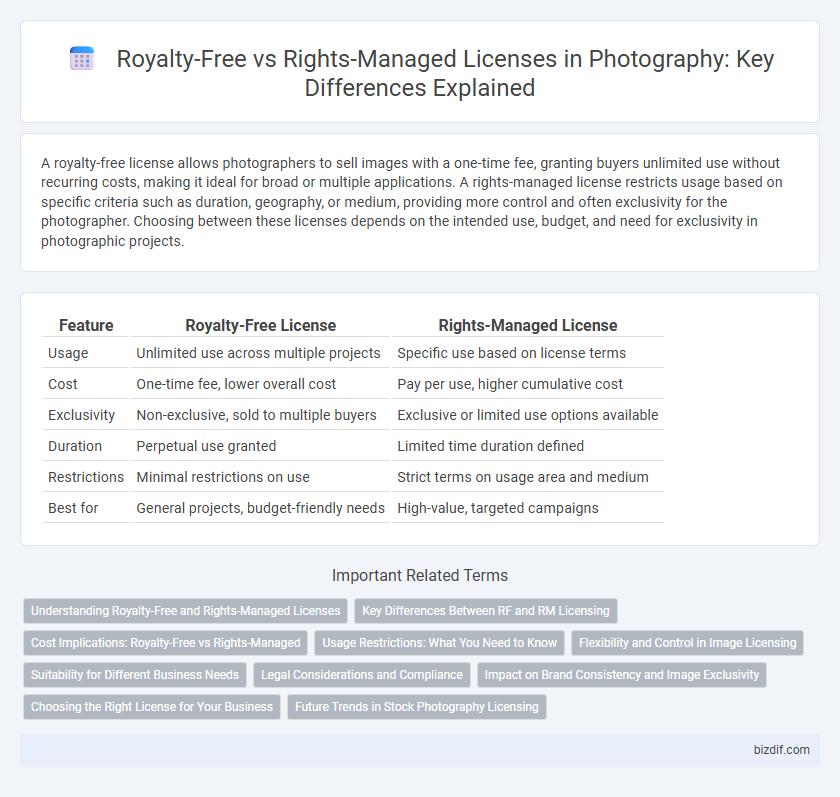A royalty-free license allows photographers to sell images with a one-time fee, granting buyers unlimited use without recurring costs, making it ideal for broad or multiple applications. A rights-managed license restricts usage based on specific criteria such as duration, geography, or medium, providing more control and often exclusivity for the photographer. Choosing between these licenses depends on the intended use, budget, and need for exclusivity in photographic projects.
Table of Comparison
| Feature | Royalty-Free License | Rights-Managed License |
|---|---|---|
| Usage | Unlimited use across multiple projects | Specific use based on license terms |
| Cost | One-time fee, lower overall cost | Pay per use, higher cumulative cost |
| Exclusivity | Non-exclusive, sold to multiple buyers | Exclusive or limited use options available |
| Duration | Perpetual use granted | Limited time duration defined |
| Restrictions | Minimal restrictions on use | Strict terms on usage area and medium |
| Best for | General projects, budget-friendly needs | High-value, targeted campaigns |
Understanding Royalty-Free and Rights-Managed Licenses
Royalty-Free licenses allow photographers and users to purchase images with a one-time fee, granting unlimited usage across various projects without additional costs, making them ideal for versatile and cost-effective image access. Rights-Managed licenses require users to pay based on specific usage parameters such as duration, geographic region, and media type, providing photographers greater control and potential for higher earnings. Understanding these licensing models helps photographers protect their work while offering clients tailored options for image use.
Key Differences Between RF and RM Licensing
Royalty-Free (RF) licenses allow unlimited use of an image after a one-time fee, without restrictions on time, location, or medium, making them cost-effective for broad applications. Rights-Managed (RM) licenses require specific usage terms, including duration, geographic area, and media type, providing exclusivity and targeted control over the image's use. RF is ideal for flexible, high-volume use, while RM suits campaigns needing exclusivity and precise licensing terms.
Cost Implications: Royalty-Free vs Rights-Managed
Royalty-free licenses typically require a one-time payment allowing unlimited use of the image, making them cost-effective for projects with multiple usages or extended timelines. Rights-managed licenses involve fees based on specific usage parameters such as duration, location, and exclusivity, often resulting in higher costs for extensive or repeated use. Choosing between royalty-free and rights-managed licenses depends heavily on budget constraints and intended scope of use in photography projects.
Usage Restrictions: What You Need to Know
Royalty-Free licenses allow unlimited use of a photograph after a one-time fee, with minimal usage restrictions, making them ideal for multiple projects without additional costs. Rights-Managed licenses restrict usage based on specific terms such as duration, geography, and media, requiring separate fees for each use or extension. Understanding these distinctions helps photographers and clients avoid legal issues and budget accurately for commercial or editorial projects.
Flexibility and Control in Image Licensing
Royalty-free licenses grant users broad flexibility to use images across multiple projects without paying additional fees, enabling cost-effective and versatile applications. Rights-managed licenses offer tighter control by limiting usage based on specific terms like duration, location, and media, ensuring exclusive or restricted exploitation tailored to the licensee's needs. Photographers and businesses prioritize royalty-free for budget-friendly scalability, while rights-managed licenses appeal to those requiring precise usage control and exclusivity.
Suitability for Different Business Needs
Royalty-Free License offers flexible usage without recurring fees, ideal for businesses needing broad, cost-effective access to images across multiple projects. Rights-Managed License provides controlled, negotiated usage rights for specific purposes, beneficial for companies seeking exclusive or limited-use content to protect brand uniqueness. Selecting between these licenses depends on the scale, budget, and exclusivity requirements of the business's marketing or creative campaigns.
Legal Considerations and Compliance
Royalty-free licenses offer broad usage rights for photography with a one-time fee and fewer legal restrictions, making compliance simpler for commercial projects. Rights-managed licenses require specific usage terms, duration, and geographic restrictions, necessitating detailed agreements to avoid legal infringement. Understanding these distinctions ensures lawful use and mitigates risks associated with copyright violations in photographic content.
Impact on Brand Consistency and Image Exclusivity
Royalty-free licenses allow brands unrestricted, repeated use of images, supporting consistent visual identity across multiple platforms without additional costs. Rights-managed licenses offer exclusive usage rights, enhancing image exclusivity and reinforcing unique brand positioning but require negotiation for each specific use. Choosing between these licenses directly impacts a brand's ability to maintain consistent, distinctive imagery aligned with strategic marketing goals.
Choosing the Right License for Your Business
Choosing the right license for your photography business hinges on understanding the usage scope and budget constraints. A Royalty-Free license allows unlimited use of images for a one-time fee, ideal for businesses needing versatile, cost-effective options without restrictions on frequency or duration. In contrast, a Rights-Managed license offers tailored usage rights for specific projects, providing exclusivity and control over distribution, which benefits brands seeking unique, high-impact visuals with predictable licensing costs.
Future Trends in Stock Photography Licensing
The future of stock photography licensing leans toward a growing preference for royalty-free licenses due to their flexibility and cost-effectiveness for users, enabling unlimited use without repeated fees. Rights-managed licenses maintain relevance primarily in high-value or exclusive image markets where precise usage control and exclusivity remain critical. Emerging trends include blockchain technology integration for transparent licensing and AI-driven image management platforms, enhancing rights enforcement and personalized licensing models.
Royalty-Free License vs Rights-Managed License Infographic

 bizdif.com
bizdif.com